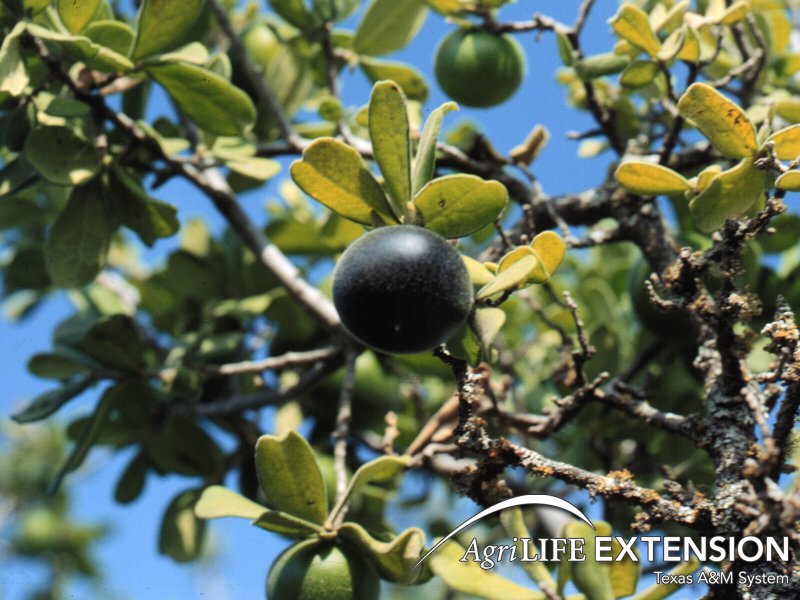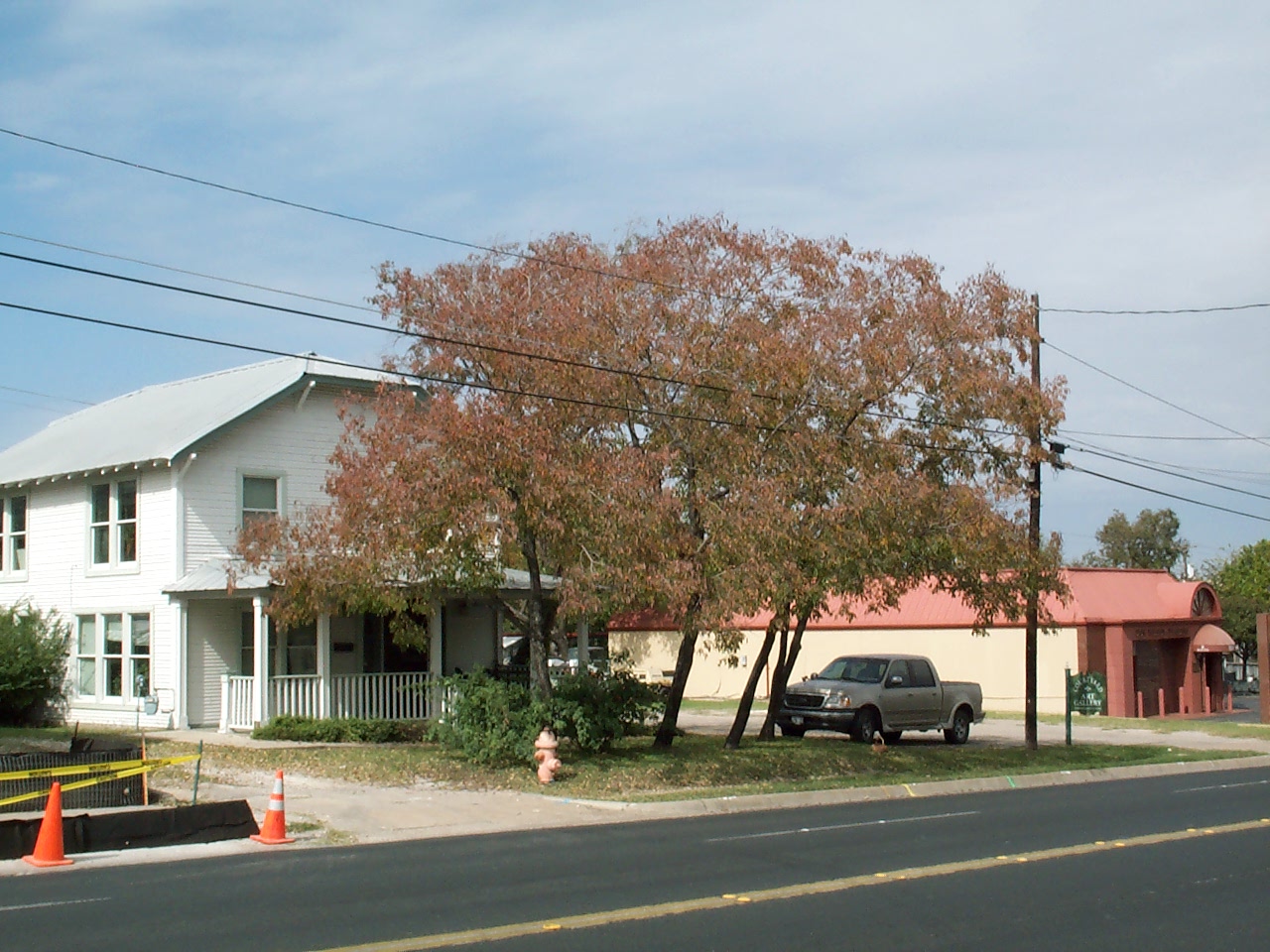An Easy to Grow Fruit in Austin
Persimmon trees are small, easy to grow, and adapted to most of Texas. The tree, its leaves, and its fruit don’t have to be sprayed because they have no serious insect or disease problems. They are somewhat drought tolerant – only needing 36 to 48 inches of water a year. In the fall, when few fruit crops are ripe, the persimmon produces fruit that is attractive and delicious. Persimmons are rich in vitamin A and have more vitamin C than citrus fruit. Mature trees can reach 40 feet high; some remain as shrubs less than 10 feet tall. Their genus name, Diospyros, means “food-of-the-gods,” which is why you’ll want to include this tree in your edible landscape.
Two Persimmons Native to Texas

Texas Persimmon (Diospyros texana)
There are two Texas native persimmons in Austin. The first, Diospyros texana, is a shrubby bush/tree found in the northern Mexico and Central and West Texas. It’s very common in the Edwards Plateau area and a common tree in the wild areas around Austin. The tree has very small, dime sized black fruit. The bark peels to reveal shades of white, gray, and even pink on the trunk. It is quite slow growing. Unfortunately, it is not graft compatible with American or Oriental persimmons.

Diospyros virginiana in an Austin front yard
The eastern persimmon, Diospyros virginiana, is native throughout the eastern U.S. including much of the eastern third of Texas right up to the Colorado River. This wild persimmon’s chief culinary contribution to our area is its superior performance as a rootstock onto which the larger Asian varieties (Diospyros kaki) are grafted.
Two Types: Astringent and Non-Astringent
Persimmon varieties may be divided into two groups; astringent and non-astringent.
Astringent types must be fully ripe and very soft before they are eaten, otherwise they cause a sensation of dryness or puckering. The texture of a fully ripe persimmon is similar to that of pudding. The fruit from astringent types is usually left on the tree until after the first frost to accelerate the softening process.
The second type of persimmon is the non-astringent. These may be eaten after turning fully orange without waiting for them to get soft, although the flavor improves with softening. The most common non-astringent varieties come from Oriental persimmon, Diospyrus kaki, which was introduced from China and Japan. The number of American persimmons non-astringent varieties has greatly expanded as this fruit became more popular.
Soil Adaptation – Choose Grafted Rootstock for Oriental Varieties
The common American persimmon is used as the rootstock for Oriental persimmon trees. It thrives in sands to bottomland as long as the soils do not stand in water is only moderately susceptible to root rot. The Oriental persimmon is highly susceptible. It is critical that all Oriental Persimmons in Austin be grafted or budded onto the common persimmon because root rot is so prevalent in Central Texas.
Culture
Persimmons have a low-chilling requirement. The tree needs only 100 hours or less. Oriental Persimmons are suitable for growing in USDA Hardiness Zones 7 to 10. They can tolerate temperatures of 0° F when fully dormant. However, because of its low chilling requirement, they may break dormancy during early warm spells only to be damaged by spring frosts later. The leaves are killed by 26° F when growing.
Plant the trees every 15 to 20 feet apart in a moderate to well-drained soil with full sun exposure. They will tolerate a variety of soil types, except a thin, rocky limestone outcropping. Diospyros texana may do better on limestone and has high ornamental value.
Persimmons don’t require a great deal of pruning. Prune trees into a central leader framework. The goal is to develop a pyramid shape with three to five main limbs at about one-foot intervals on the trunk, beginning at about three feet above ground level. Prune mature plants by removing crossover, shaded, diseased, and broken branches. Open the canopy to prevent self shading, reduce excessively vigorous shoot growth, and regulate crop load. Preserve limbs that grow off the leader at wide angles and remove those that don’t. Persimmon fruit develops on branches that have grown in the current season. To keep the limbs from drooping, prune secondary branches so that the bearing shoots remain close to the main branches.
Provide supplemental irrigation during spring growth and during summer. Water deeply and as infrequently as possible.
Persimmons don’t require a lot of fertilizer. If needed, apply fertilizer as the new shoots emerge in early spring. A general recommendation is 40 pounds of actual nitrogen per acre per year. If shoots grow more than 3 feet, fertilize less.
Persimmons are virtually pest free. About the only significant pests seen are the twig girdler, which occasionally shows up to prune off branch ends and a leaf spot fungus. Neither requires spraying. The most significant loss comes from wildlife. Persimmons are a favorite for deer and squirrels who tend to eat the fruit before it’s ripe.
Fruit Drop and Harvest
Persimmons typically produce seedless fruit which drop easily. Seedless fruit are very finicky and will drop if the tree experiences growth problems from too much fertilizer, excessive heat, cold, water or drought. Heavy mulch and appropriate irrigation will reduce, but never eliminate, fruit drop.
The fruit ripens in mid to late fall. Their bright orange fruits hang on the tree on into early winter after the leaves have fallen for a beautiful, ornamental effect.
Variety Recommendations for Austin and Travis County
| Variety | Description |
| Eureka | Heavy producing, medium sized, flat-shaped, red persimmon of extremely high fruit quality. The tree is relatively small and self-fruitful. Fruit typically contain seeds. ‘Eureka’ has proven to be the best commercial variety in Texas. |
| Hachiya | Productive, very large, cone shaped, seedless persimmon with bright orange skin. The tree is vigorous and upright. It has been an outstanding Texas variety and makes an excellent dual purpose fruit and ornamental specimen. |
| Tane-nashi | Moderately productive, cone-shaped, orange persimmon. The tree is vigorous and upright. The fruit stores extremely well on the tree and is seedless. It makes an excellent landscape ornamental. |
| Tamopan | Moderately productive, very large, flat, orange, persimmon with a distinctive ring constriction near the middle of the fruit. The tree is the most vigorous and upright of the varieties grown in Texas. |
| Fuyu | Medium-sized, non-astringent, self-fruitful persimmon. The fruit shape is flat-ish, orange, and is high quality. Can be susceptible to freeze damage. |
| Izu | Bears medium-sized, non-astringent fruit. It seems to be more cold hardy than ‘Fuyu ‘and ripens in September. |
| Fankio | Produces large, conical, with vivid gold fruit. It is one of the prettiest persimmons; the leaves turn bright red as the gold fruit ripens in the fall |
